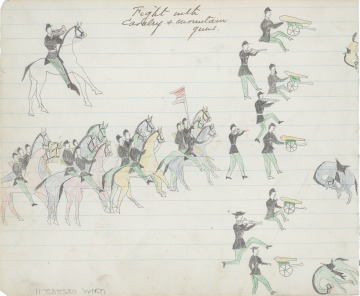1870: Commercialization, destruction of traditional foods hurt tribes
Tribes across the West suffer further land loss as settlers, miners, and ranchers move into their territories. The deliberate eradication of buffalo, the commercialization of fisheries, and the commitment of vast areas of arid land to ranching leads to famine. Overgrazing by livestock destroys plants that tribes have used to feed and heal their people for generations.
Tribes on the Pacific Coast are prevented from gathering shellfish by white private ownership of land. Canneries commercialize crops that the Natives harvest in the wild, without regard for maintaining the wild stock, which declines significantly. As a result, tribes become more dependent on government rations and government medical care, when available.
- Theme
- Land and Water
- Region
- California, Great Basin, Great Plains, Northwest Coast
Four Horns, a Hunkpapa Lakota, created this ledger drawing titled "Sitting Bull Shoots a Frontiersman," in 1870.
Ledger art is a term for narrative drawing or painting on paper or cloth created by Native artists. Ledger art was created primarily from the 1860s to the 1930s, but also continues today. The term comes from the accounting ledger books that were a common source for paper for different Native artists during the late 19th century.
Courtesy National Anthropological Archives, Smithsonian Institution
Kiowa artist Etahdleuh Doanmoe created this ledger drawing of mounted warriors engaging cavalry and infantry formations in 1880.
Ledger art is a term for narrative drawing or painting on paper or cloth created by Native artists. Ledger art was created primarily from the 1860s to the 1930s, but also continues today. The term comes from the accounting ledger books that were a common source for paper for different Native artists during the late 19th century.
Courtesy National Anthropological Archives, Smithsonian Institution
Tribes across the West resist, but face further losses. In 1879, a Kiowa artist imprisoned at Fort Marion, Florida, created this ledger drawing with the inscription: “Fight with cavalry and mountain guns."
Ledger art is a term for narrative drawing or painting on paper or cloth created by Native artists. Ledger art was created primarily from the 1860s to the 1930s, but also continues today. The term comes from the accounting ledger books that were a common source for paper for different Native artists during the late 19th century.
Courtesy National Anthroplogical Archives, Smithsonian Institution
Tribes across the West resist, but face further losses. In 1879, a Kiowa artist imprisoned at Fort Marion, Florida, created this ledger drawing with the inscription: “Fight with cavalry and mountain guns."
Ledger art is a term for narrative drawing or painting on paper or cloth created by Native artists. Ledger art was created primarily from the 1860s to the 1930s, but also continues today. The term comes from the accounting ledger books that were a common source for paper for different Native artists during the late 19th century.
Courtesy National Anthroplogical Archives, Smithsonian Institution



